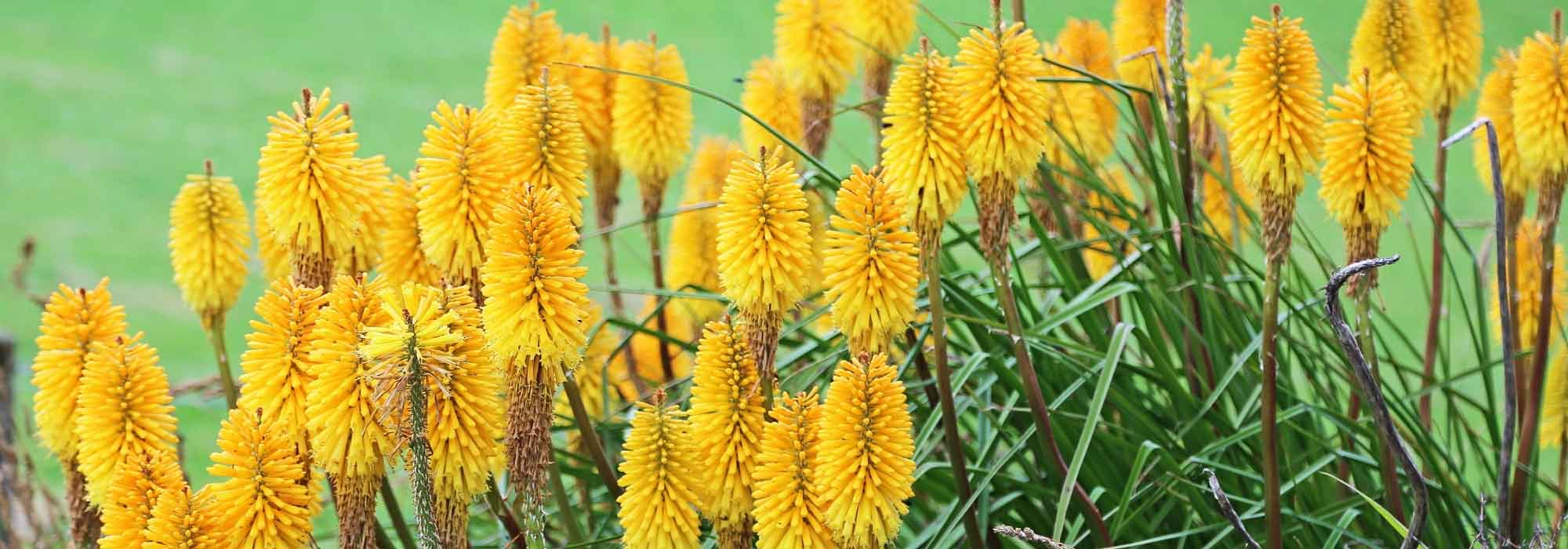
Choosing a kniphofia
How to choose from the many kniphofia varieties?
Contents
These are perennials with spectacular flowering, whose tall, slender inflorescences reach towards the sky on high stems, hence their evocative common name “Red Hot Pokers.” They are also known as Tritoma or False Aloe. Kniphofia are often planted in mild climates, but they bring a welcome touch of exoticism to many regions as they are still quite hardy and form opulent clumps of elongated, fleshy leaves. There are about 70 species in this genus native to South Africa and Madagascar: enough to leave you puzzled when it comes to choosing the ones best suited to your planting projects! But rest assured, based on the criteria that matter to you, you will be able to find your way and plant the most suitable ones: flower colour, flowering period, size, exposure… we are here to help you navigate!
Based on the colour of the flowers
The red-hot poker is highly floriferous, with a colour palette ranging from vibrant orange-red to cream white, including golden yellow. Many varieties are also bicoloured or feature a gradient of colour. To help you choose from our selection of Kniphofias and best pair them in your borders with your bushes and perennials, here they are classified by the colour of their flowers.
The most vibrant: to add a touch of dynamism to the garden
- Kniphofia ‘Alcazar’
- Kniphofia ‘Elvira’
- Kniphofia ‘Mango Popsicle’
- Kniphofia ‘Nancy’s Red’
- Kniphofia ‘Papaya Popsicle’
- Kniphofia ‘Red Rocket’
- Kniphofia ‘Redhot Popsicle’
 Kniphofia ‘Alcazar’, Kniphofia ‘Nancy’s Red’, Kniphofia ‘Elvira’ and Kniphofia ‘Mango Popsicle’
Kniphofia ‘Alcazar’, Kniphofia ‘Nancy’s Red’, Kniphofia ‘Elvira’ and Kniphofia ‘Mango Popsicle’
The yellows: bringing sunshine to the borders
- Kniphofia ‘Banana Popsicle’
- Kniphofia ‘Bees Lemon’
- Kniphofia ‘Dorset Sentry’
- Kniphofia ‘Limelight’
- Kniphofia ‘Little Maid’
- Kniphofia ‘Minister Verschuur’
- Kniphofia ‘Vanilla’
- Kniphofia ‘Wrexham Buttercup’
- Kniphofia citrina
- Kniphofia ‘Tawny King’
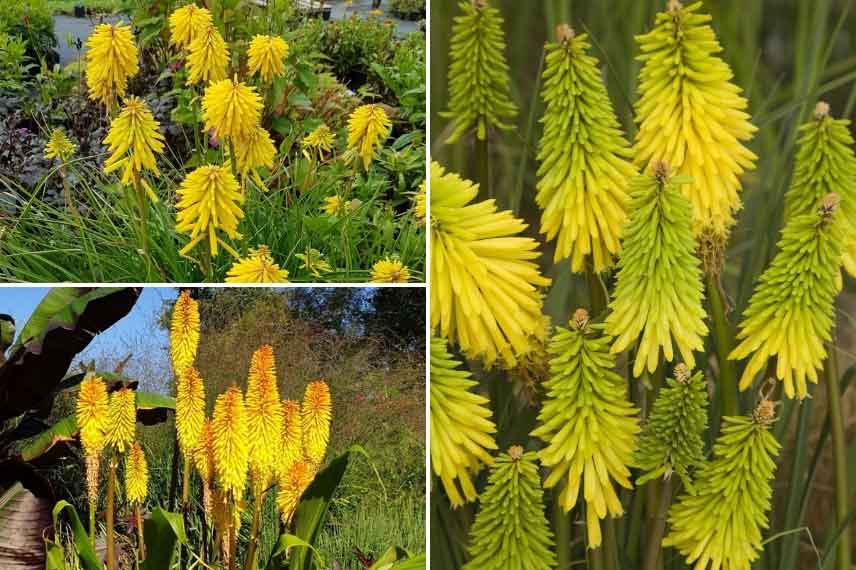 Kniphofia ‘Banana Popsicle’, Kniphofia ‘Wrexham Buttercup’ and vertically Kniphofia ‘Bees Lemon’
Kniphofia ‘Banana Popsicle’, Kniphofia ‘Wrexham Buttercup’ and vertically Kniphofia ‘Bees Lemon’
The cream whites: for a touch of freshness
 Kniphofia ‘Green Jade’, Kniphofia ‘Ice Queen’ and Kniphofia ‘Pineapple Popsicle’
Kniphofia ‘Green Jade’, Kniphofia ‘Ice Queen’ and Kniphofia ‘Pineapple Popsicle’
Dare to go bicoloured
- Kniphofia ‘Flamenco’
- Kniphofia northiae
- Kniphofia uvaria
- Kniphofia ‘Orange Vanilla Popsicle’
- Kniphofia ‘Royal Standard’
- Kniphofia rooperi
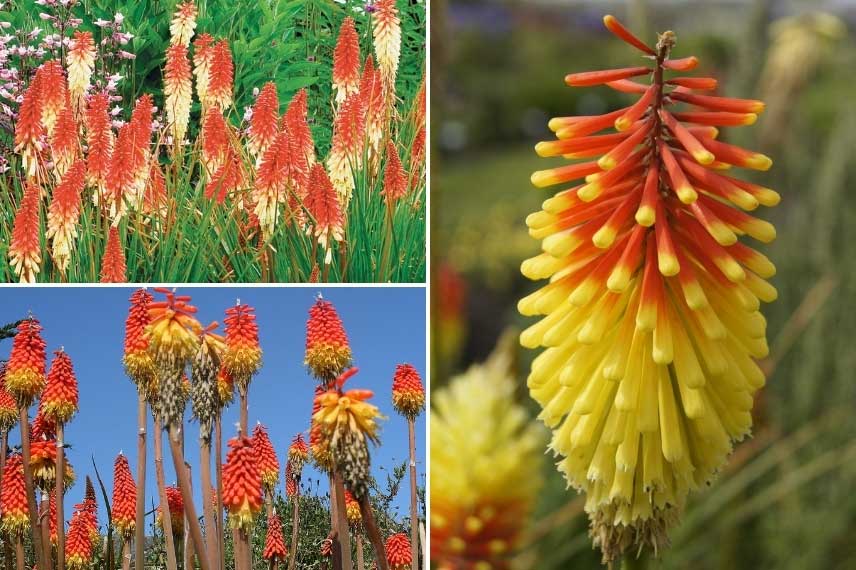 Kniphofia ‘Orange Vanilla Popsicle’, Kniphofia uvaria and vertically Kniphofia ‘Royal Standard’
Kniphofia ‘Orange Vanilla Popsicle’, Kniphofia uvaria and vertically Kniphofia ‘Royal Standard’
According to the flowering period
Depending on the species, Kniphofia flowers from April to September for the great delight of gardeners. They are therefore in bloom during the summer months, but some are nonetheless earlier, while others linger into the late season, sometimes until October. The spring varieties are Kniphofia ‘Mango Popsicle’, ‘Nancy’s Red‘, ‘Orange Vanilla Popsicle’ and ‘Pineapple Popsicle’, which start their flowering as early as May in full sun and well-drained soils. Other species generally take over from June-July, and the autumn varieties will continue to delight borders or rockeries with their generous spikes until October. If you wish to extend the presence of Tritoma spikes in a border, plant the yellow Kniphofia ‘Bees Lemon’ and Kniphofia ‘Little Maid’, Kniphofia ‘Green Jade’ a very bright green-yellow, and Kniphofia rooperi with its bicoloured spikes orange at the base and yellow.
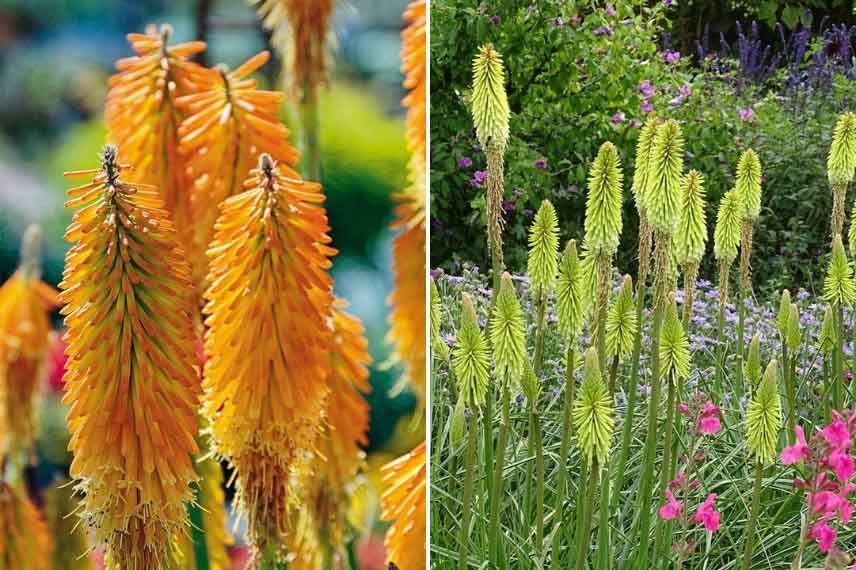
Kniphofia ‘Mango Popsicle’, in bloom from May and Kniphofia ‘Green Jade’ in bloom until late season
Discover other Kniphofia - Red-Hot Pokers
View all →Available in 0 sizes
Available in 2 sizes
Available in 2 sizes
Available in 1 sizes
Available in 2 sizes
Available in 1 sizes
Available in 1 sizes
Available in 2 sizes
Available in 1 sizes
Available in 1 sizes
Small, medium, and giant!
- The small (under 50cm): Plant at the edge of the bed the short yellow spikes of Kniphofia ‘Banana Popsicle’, Kniphofia ‘Papaya Popsicle’ red-orange and Kniphofia ‘Orange Vanilla Popsicle’ with tighter spikes and a gradient of cream to red-orange colours.
- The medium (50 to 80cm): Most Kniphofia will fit into beds at an intermediate height between 50cm and 1.20m. Accompany them with small perennial groundcovers in front and bulbs for a mutual enhancement of flowers and foliage.
- The giants (+1m): These large Kniphofia raise their cylindrical spikes above masses of more airy perennials, tufts of grasses, or shrubs with complementary flowering: Kniphofia uvaria, Kniphofia ‘Alcazar’ and Kniphofia rooperi to name just a few.
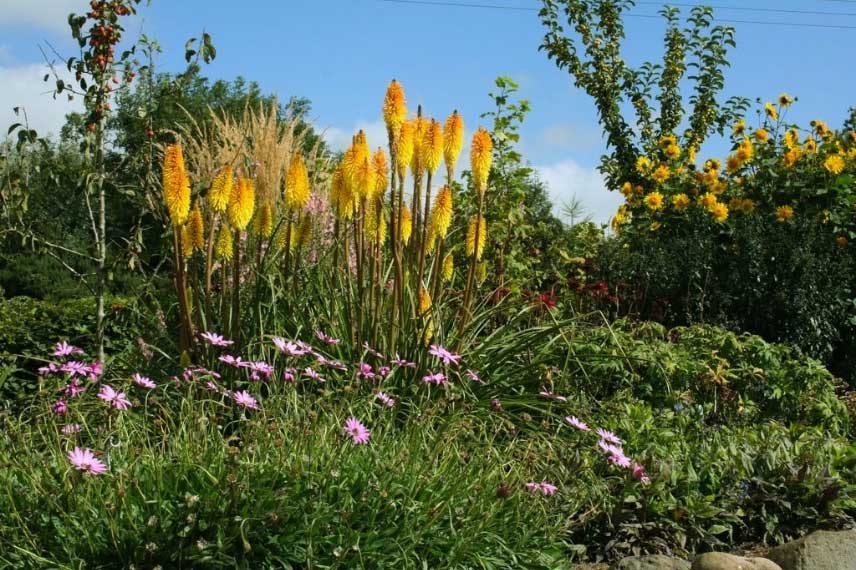
Kniphofia ‘Wrexham Buttercup’ dominating the scene with its impressive size and spectacular flowers
Read also
7 ideas to pair KniphofiaDeciduous foliage / evergreen foliage
The foliage of most Tritoma is deciduous. If having foliage all year round is essential for you, Kniphofia ‘Bees Lemon’, Kniphofia citrina and Kniphofia ‘Limelight’ have evergreen foliage, which extends their appeal throughout the year. The dominant colour of their flowering is golden yellow to lemon yellow. Kniphofia ‘Flamenco’ and Kniphofia rooperi are also evergreen, with flowers in the range of oranges.
According to the exposure
Most Kniphofia thrive in full sun. If you have no choice but to plant them in more shade, you will need to choose from those that can manage with only a few hours of sun per day:
- The red Kniphofia ‘Red Rocket’
- The orange Kniphofia ‘Alcazar’ and Kniphofia uvaria
- And the yellow Kniphofia ‘Dorset Sentry’, , Kniphofia ‘Little Maid’ and Kniphofia ‘Wrexham Buttercup’
According to the use
The extraordinary appearance of Kniphofia allows for the creation of exotic atmospheres. At the edge of borders, prefer compact varieties, paired with Hesperaloe Parviflora, New Zealand Flax, or Prickly Pears. To create a truly spectacular look and a sense of dislocation, craft stunning scenes with large-growing Tritomas like Kniphofia ‘Royal Standard’ or Kniphofia rooperi, paired with yuccas and dasylirion. For an exotic touch on the terrace, the various Red Hot Pokers will also thrive well in pots or large planters, provided you ensure good drainage and apply mulch at the base for better protection and to retain moisture from watering. The hardiest, such as Kniphofia uvaria, which withstands temperatures around -15°C, will adapt perfectly in colder climate regions.
In a Mediterranean garden, the orange of the tritoma harmoniously complements the blue of agapanthus, the bright yellow of Phlomis fruticosa, and the blue-green foliage of Euphorbia Characias and pythiusa.
For a more naturalistic creation, the yellow of Kniphofia ‘Minister Verschuur’ and the cream white of Kniphofia ‘Ice Queen’ can be placed in a border featuring gradients of yellow and white alongside Lysimachia lichiangensis, Anthemis tinctoria ‘Kelwayi’, and tall lupins. All enhanced by the deep purple foliage and bright red flowers of Lobelia fulgens‘Queen Victoria’.

“Red Hot Pokers” can enchant various garden atmospheres: exotic, Mediterranean, or more natural
- Subscribe!
- Contents
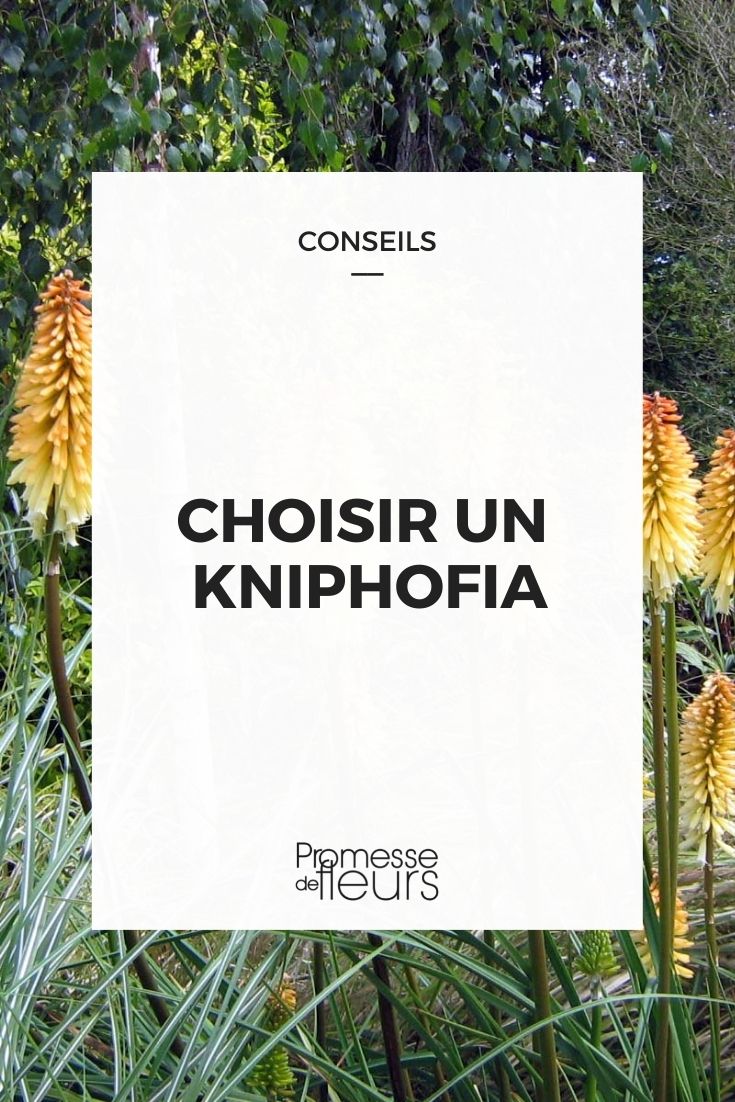































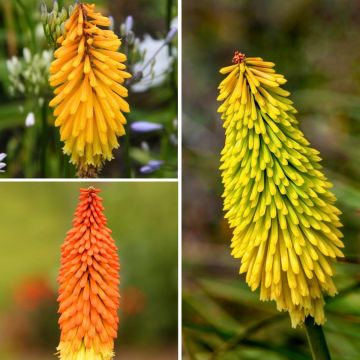
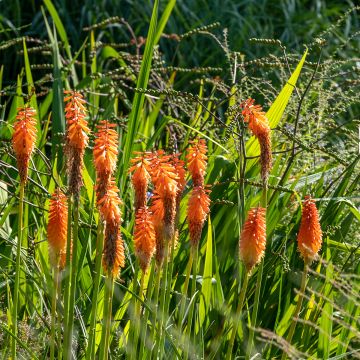


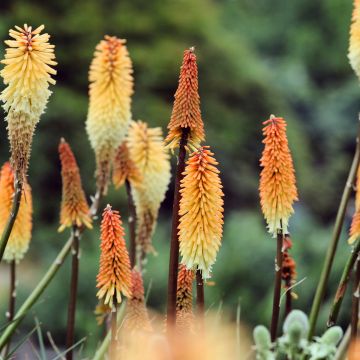

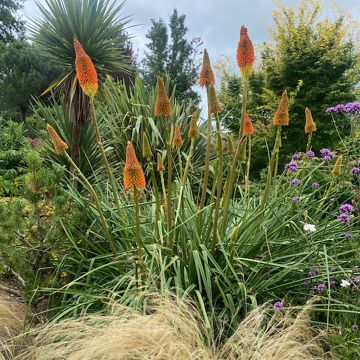
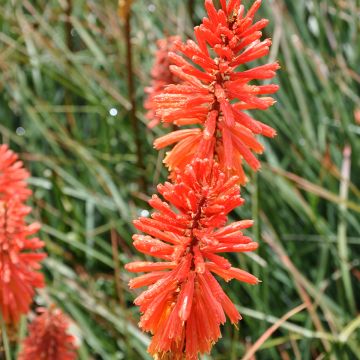
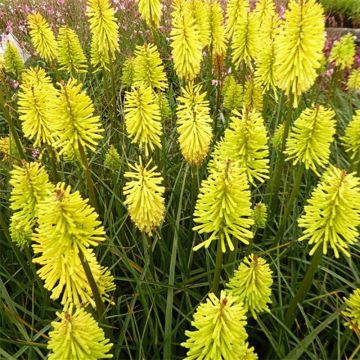
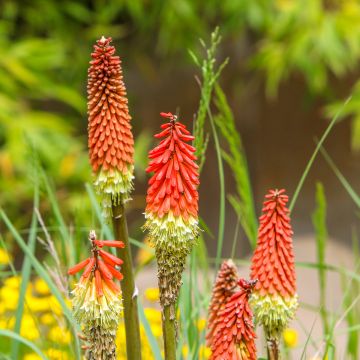
Comments